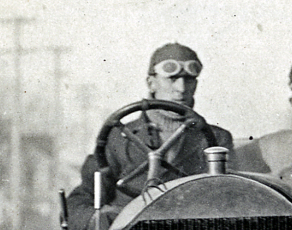
William Bourque
First driver to be killed at the Indianapolis Motor Speedway
Nationality: American
Born: 1883
Died: August 21, 1909 Indianapolis, Indiana 26 years
The Indy 500 officially began in 1911, but the Indianapolis Motor Speedway opened in 1909. After having a hot-air balloon race and a motorcycle race at the track, three days of auto racing was held beginning on August 20th. When the track was created, it was not paved with bricks, but was made up of crushed stone and tar. This surface would prove to be insufficient, and the whole 2.5 miles of track would be paved with over 3 million red bricks before the start of the 1911 Indy 500.
On the first day, William Bourque and his mechanic, Harry Holcomb were the first to die from injuries received in a crash at the new Speedway. Bourque drove for Knox Company. He had started at the bottom in the Knox factory, serving his apprenticeship, and had become a tester. Bourque was an able driver, with outstanding nerve, judgment, and physical strength. He had made a local reputation as an amateur bicycle rider as a youth before entering professional racing in hill-climbing events. The week before his crash, Bourque had raced at Richfield Springs, NY and won four prizes, which were presented to him by Vice-President Sherman.
Bourque had just won the third of the preliminary events on that first day of racing: five miles for stripped stock cars of 301-450 c.i. piston displacement. His timing was 0.9 seconds faster than Bob Burman's. Louis Chevrolet was third.
Bourque was again battling Burman (who finally won the race) for the lead in the Prest-O-Lite Trophy Race. Witnesses to the accident agreed that a quick glance backwards cost him his life and his mechanics life. On lap 58 as Bourque came through turn 4, Holcomb signaled the approach of a car. Bourque glanced back. Private Frank Brandoer who was near the accident said when he looked back, the wheel slipped and the car swerved slightly, hit a rut and then went into the ditch and flipped over. Holcomb was thrown went flying into a fence post at 75 mph and smashed his head, killing him instantly. Bourque was trapped under the car. Both axles were thrown from the track and one axle landed toward the ditch. The accident occurred on the front stretch just above the bridge that spanned a small stream from 1912-1916, about 250 yards from the judges. Bob Burman and Louis Chevrolet said that they had noticed their cars were inclined to skid at this place on the track and they always hugged close to the inside.
Although hundreds of fans left the stands, the race continued as physicians and resuers dodged the whizzing cars to carry the victims across the track. Holcomb (22) also had two broken arms and and several broken ribs. Bourque (26) suffered a fractured skull, broken legs, and a punctured lung. He was rushed to the hospital but never regained conscious. Both men were from Springfield Massachusetts, where the Knox factory was located. Bourqe was born in West Farnham, Canada. He had planned to be married in the fall. Holcomb, a test for Knox for two years, had relatives a few miles away in West Granville. This season was his first in racing. He had ridden with Bourque earlier in the year at Crown Point, where the two had finished 2nd.
The V.P. of Knox had insured the lives of the two men for $25,000 in favor of their relatives, without the drivers' knowledge. (Average yearly income then was $800/year). George Crane, a Knox sales rep, said "This will probably end our racing. We will probably enter no more cars in automobile races. It is simply suicide; that all it is." The Knox Company, however, continued to race.
The Indianapolis News reported for August 21st: "There were more women in the crowd than on Thursday and they appeared to be the most interested of the spectators. The killing of the two men, it seemed, only served to increase the excitement."
On August 22nd, the third day of the event, Claude Kellum was riding in a National car as the mechanic. When the car was forced out of the race, Killum sat unhappily in the pit. Robert Lyne the mechanic for another National car, ran across the infield from the far side of the track to tell the pit crew that his driver, Charlie Merz, needed a new battery. He then collapsed from exhaustion. Kellum happily came to the rescue with a new battery and took over for Lyne.
During the race, as they were driving over the bridge over the stream, their right front tire blew out. The car catapulted into the air and through the fence into a crowd of spectators, where it turned over and pinned Merz underneath. Kellum was thrown against a fence post hard enough to knock him out. An hour later he died. Claude Kellum was a resident of Indy. He had worked for the National Company for several years. He was 35 y/o and left a wife and two children. Also killed were two spectators - James West of Indianapolis and Homer Jolliff of nearby Franklin Indiana.

Really think the couple up on Jericho Tpke are the same couple that officially toured the LIMP 1958 - 1967. Could also…